Writing Effective Emails
E-mail is familiar to most students and workers. In business, email has largely replaced print hard copy letters for external (outside the company) correspondence, and in many cases, it has taken the place of memos for internal (within the company) communication.
E-mail can be very useful for messages that have slightly more content than a text message, but it is still best used for fairly brief messages. Many businesses use automated e-mails to acknowledge communications from the public, or to remind associates that periodic reports or payments are due. You may also be assigned to “populate” a form e-mail in which standard paragraphs are used, but you choose from a menu of sentences to make the wording suitable for a particular transaction.
E-mails may be informal in personal contexts, but business communication requires attention to detail, awareness that your e-mail reflects you and your company, and a professional tone so that it may be forwarded to any third party if needed. E-mail often serves to exchange information within organizations. Although e-mail may have an informal feel, remember that when used for business, it needs to convey professionalism and respect. Never write or send anything that you wouldn’t want read in public or in front of your company president.
TIPS FOR WRITING EFFECTIVE WORKPLACE EMAILS
As with all writing, professional communications require attention to the specific writing context, and it may surprise you that even elements of form can indicate a writer’s strong understanding of audience and purpose. The principles explained here apply to the educational context as well; use them when communicating with your instructors and classroom peers.
- Open with a proper salutation. Proper salutations demonstrate respect and avoid mix-ups in case a message is accidentally sent to the wrong recipient. For example, use a salutation like “Dear Ms. X” (external) or “Hi Barry” (internal). Never use the title Mrs. as you cannot assume a woman is married. If the gender of a person is not evident, use their entire name, like this: “Dear Sam Jones”
- Include a clear, brief, and specific subject line. This helps the recipient understand the essence of the message. For example, “Proposal attached” or “Your question of 10/25.”
- Close with a signature. Identify yourself by creating a signature block that automatically contains your name and business contact information.
- Avoid abbreviations. An e-mail is not a text message, and the audience may not find your wit cause to ROTFLOL (roll on the floor laughing out loud).
- Be brief. Omit unnecessary words.
- Use a good format. Divide your message into brief paragraphs for ease of reading. A good e-mail should get to the point and conclude in three small paragraphs or less.
- Reread, revise, and review. Catch and correct spelling and grammar mistakes before you press “send.” It will take more time and effort to undo the problems caused by a hasty, poorly written e-mail than to get it right the first time.
- Reply promptly. Watch out for an emotional response—never reply in anger—but make a habit of replying to all e-mails within twenty-four hours, even if only to say that you will provide the requested information in forty-eight or seventy-two hours.
- Use “Reply All” sparingly. Do not send your reply to everyone who received the initial e-mail unless your message absolutely needs to be read by the entire group.
- Avoid using all caps. Capital letters are used on the Internet to communicate emphatic emotion or yelling and are considered rude.
- Test links. If you include a link, test it to make sure it is working.
- E-mail ahead of time if you are going to attach large files (audio and visual files are often quite large) to prevent exceeding the recipient’s mailbox limit or triggering the spam filter.
- Give feedback or follow up. If you don’t get a response in twenty-four hours, e-mail or call. Spam filters may have intercepted your message, so your recipient may never have received it.
*For more info watch Will’s “Writing Effective Emails” slideshow on Prezi.
Figure 1.1 below shows a sample email that demonstrates the principles listed above:
From: Steve Jobs <sjobs@apple.com> To: Human Resources Division <hr@apple.com> Date: September 12, 2015 Subject: Safe Zone Training Dear Colleagues: Please consider signing up for the next available Safe Zone workshop offered by the College. As you know, our department is working toward increasing the number of Safe Zone volunteers in our area, and I hope several of you may be available for the next workshop scheduled for Friday, October 9. For more information on the Safe Zone program, please visit www.cocc.edu/multicultural/safe-zone-training. Please let me know if you will attend. Steve Jobs |
Figure 1.2 is another example of a standard email:

The following video, “10 Tips for Writing an Awesome Business Email” from LetThemTalkTV.com: provides some helpful tips for writing successful professional emails:
Additional Resources
- “Yes, There Is a Right Way to Write an Email,” an article from TED Ideas
- “How to Communicate with Your Instructors and Advisors,” from LBCC’s Destination Graduation handbook.
*This page borrows from the following sources:
"Correspondence." Technical Writing Essentials. Source link.

